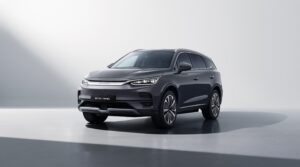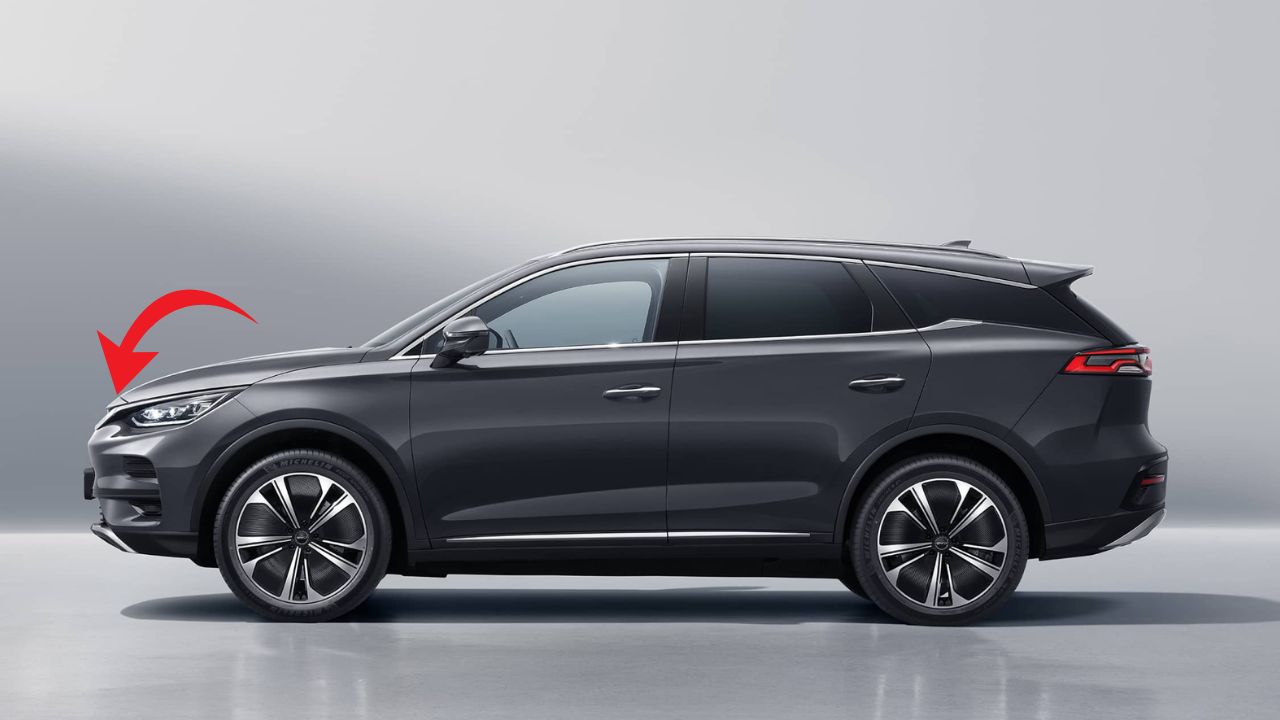The Australian automotive landscape is about to witness another significant shift as BYD has officially confirmed plans to introduce a seven-seat SUV to the Australian market, with the company’s CEO describing it as a “top priority”. This announcement marks a crucial step in BYD’s ambitious expansion strategy, positioning the Chinese automaker to directly challenge established family SUV giants like the Toyota Kluger, Kia Sorento, and Hyundai Santa Fe.
BYD’s Strategic Push Into Australia’s Family SUV Market
BYD’s Australian distributor EVDirect expects to more than double its sales by the end of 2025, targeting over 40,000 annual sales. This aggressive growth strategy hinges significantly on introducing vehicles that fill crucial market gaps – and seven-seat family SUVs represent one of the most lucrative segments in the Australian market.

David Smitherman, CEO of EVDirect, has confirmed that a seven-seater SUV will be part of an “onslaught” of new models coming to market locally. The timing couldn’t be better, as Australian families increasingly seek electrified alternatives to traditional petrol-powered people movers.
The Tang L: Australia’s Likely Seven-Seat Champion
While BYD hasn’t explicitly named the model destined for Australia, all evidence strongly points to the recently unveiled Tang L as the prime candidate. Officials from the company previously ruled out the possibility of the current Tang being made in right-hand-drive, strongly suggesting the forthcoming Tang L is likely to be the model earmarked for Australian buyers.
The Tang L represents a comprehensive evolution of BYD’s seven-seat SUV philosophy. Just unveiled in China, the Tang L offers three rows of seats and a choice of either electric or plug-in hybrid (PHEV) powertrains. This dual approach mirrors BYD’s successful strategy with other Australian models like the Sealion 6, providing consumers with flexibility while catering to different driving needs and charging infrastructure concerns.
Performance That Demands Attention
The Tang L’s performance specifications are genuinely impressive, positioning it as more than just a practical family hauler. The electric Tang L can be optioned with dual electric motors making 230kW and 580kW – propelling the family SUV to 100km/h from a standstill in less than four seconds. These figures place the Tang L in supercar territory while maintaining seven-seat practicality.
For those preferring the security of extended range, the plug-in hybrid variants offer between 135 and 165 kilometres of pure-electric driving range before the petrol engine activates. The PHEV system uses a 115kW 1.5-litre turbo-petrol engine, a 200kW electric system, and claims a 115km electric range with a 1150km combined range.
Design Excellence Meets Cultural Heritage
BYD hasn’t simply created another generic seven-seater. The Tang is styled under the direction of German designer Wolfgang Egger – former chief designer for Audi, Lamborghini and Alfa Romeo, and now design director for BYD. This European design sensibility, combined with Chinese cultural elements, creates a distinctive aesthetic that stands apart from both European and Japanese competitors.
The SUV’s front design, dubbed the “Loong Face,” embodies strength and prestige, while the taillights take inspiration from traditional bamboo weaving techniques. This cultural integration extends to the interior, where the dual-color scheme of orange and matte grey blends modern technology with heritage elements.
Interior Space That Actually Delivers
One of the most compelling aspects of the Tang L is its genuine commitment to usable space. The SUV offers a three-row, seven-seat (2+3+2) layout, providing versatility for families and adventurers alike. Unlike some seven-seaters where the third row feels like an afterthought, the Tang L has been engineered from the ground up to accommodate seven adults comfortably.
The generous boot capacity starts at 675 liters but expands to 960 liters with the third-row seats folded and an impressive 1,960 liters with the second row down—a full 440-liter increase over its predecessor. This level of cargo flexibility positions the Tang L as a genuine alternative to traditional full-size SUVs.
Technology That Sets New Standards
BYD’s approach to in-vehicle technology continues to push boundaries, and the Tang L exemplifies this philosophy. The interior features a 15.6-inch center control screen, an AR-HUD display, a D-shaped steering wheel, and hidden air-conditioning vents. This isn’t technology for technology’s sake – each element serves a practical purpose while enhancing the overall user experience.
The vehicle’s charging capabilities represent a significant advancement in EV technology. Built on an ultra-high-voltage platform exceeding 1000V, it supports dual-gun fast charging (500 kW on each side), significantly reducing charging times. For Australian drivers concerned about charging infrastructure, reports suggest that with a 120 kW charging pile, the battery can go from 16% to 80% in just 10 minutes, even in freezing conditions as low as -30°C.
Safety Without Compromise
Family vehicles must prioritize safety above all else, and the Tang L delivers comprehensively in this area. BYD TANG proudly achieved the ultimate overall safety rating of 5 stars from Euro NCAP, demonstrating its commitment to protecting occupants across all scenarios.
The vehicle is equipped with 8 ultrasonic radars, 5 high-precision millimeter-wave radars, 4 intelligent driving surround view cameras and 1 high-perception intelligent driving camera. This comprehensive sensor suite enables advanced driver assistance features that actively work to prevent accidents rather than simply responding to them.
Market Competition and Positioning
The seven-seat SUV segment in Australia has traditionally been dominated by established players like Toyota, Kia, and Hyundai. Seven seat electric SUVs are rare in Australia, with the expensive Kia EV9 and Mercedes-Benz EQB and EQS prominent among them. The BYD Tang would undoubtedly undercut them by tens of thousands of dollars.
This pricing advantage could prove decisive in the Australian market. The Tang L is set to launch in China first, with an expected starting price of 300,000 yuan (~AUD 63,000). While Australian pricing will likely carry a premium due to import duties and local compliance costs, BYD’s track record suggests competitive positioning against traditional alternatives.
The Hybrid Advantage
BYD’s decision to offer both fully electric and plug-in hybrid variants addresses one of the most significant barriers to EV adoption in Australia – range anxiety. The dual-motor EV features a 109kWh battery, all-wheel drive, 0-100km/h in a claimed 4.9sec and a WLTP range of 530km. This range capability matches or exceeds most Australian families’ daily driving needs while providing confidence for interstate travel.
The plug-in hybrid option serves as a bridge technology for consumers not yet ready to commit fully to electric driving. With the ability to complete most daily journeys on electric power alone while retaining the security of a petrol engine for longer trips, the PHEV Tang L could prove particularly appealing to Australian families.
Timeline and Market Impact
The importer and distributor of BYD in Australia, EVDirect, has yet to confirm the Tang L officially, however it’s possible the model could go on sale in Australia as soon as 2026. This timeline aligns with BYD’s broader expansion strategy and allows sufficient time for right-hand-drive development and local compliance testing.
The impact on the Australian market could be substantial. For 2025 EVDirect has targeted 50,000 total sales. That will be a little over double the number it expects to hit in 2024. In 2026 it is aiming for a Mazda-challenging 100,000 sales and the number two slot in the market.
Beyond Just Another SUV
The Tang L represents more than simply another model addition to BYD’s Australian lineup. It signals the company’s intention to compete across all major vehicle segments, from compact cars to full-size SUVs. BYD aims to become the largest EV brand in the world, and Australia plays a crucial role in this global ambition.
The Australian market’s embrace of SUVs makes it an ideal testing ground for BYD’s seven-seat strategy. Success here could provide valuable insights for other right-hand-drive markets and demonstrate the Tang L’s viability against established Western competitors.
The Broader BYD Ecosystem
The Tang L won’t exist in isolation within BYD’s Australian range. By the end of 2025, BYD’s model range is set to include the Atto 2 small electric SUV, a three-row seven-seat SUV and the premium U8 large SUV, branded as Denza. This comprehensive lineup strategy ensures BYD can capture customers across different price points and use cases.
The company’s recent success with the Shark 6 plug-in hybrid ute demonstrates Australian consumers’ willingness to embrace BYD’s technology when packaged appropriately. The Shark 6 PHEV ute is expected to be the biggest volume player in 2025, providing a strong foundation for the Tang L’s introduction.
Frequently Asked Questions
When will the BYD seven-seat SUV be available in Australia?
The BYD Tang L is expected to launch in Australia as early as 2026, though official confirmation from BYD Australia is still pending. The timeline depends on right-hand-drive development and local compliance testing.
What will be the expected price range for the BYD seven-seat SUV in Australia?
Based on Chinese pricing of approximately 300,000 yuan (~AUD 63,000), the Australian model is expected to start around $65,000-$70,000, positioning it competitively against the Toyota Kluger and similar seven-seat SUVs.
Will the BYD seven-seat SUV be available in both electric and hybrid versions?
Yes, BYD plans to offer both fully electric and plug-in hybrid variants of their seven-seat SUV in Australia, following the successful strategy used with other models like the Sealion 6. This provides consumers with flexibility based on their driving needs and charging infrastructure access.
The confirmation of BYD’s seven-seat SUV for Australia represents a pivotal moment in the country’s automotive evolution. With advanced technology, competitive pricing, and genuine seven-seat practicality, the Tang L has the potential to reshape family vehicle expectations while accelerating Australia’s transition to electrified transport. As BYD continues its aggressive expansion strategy, Australian families can look forward to having another compelling option in the increasingly important seven-seat SUV segment.
